Lotus Cars Service Bulletin 2000/1
Introduction to the 340R.
Service bulletin issued March 2000
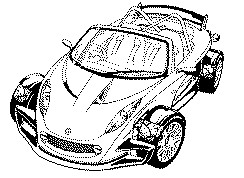
TITLE Introduction of Elise 340R.
REASON: To advise features and specification.
CONCEPT
The
Elise 340R is based on the standard Elise chassis, but uses completely
different bodywork and interior, and a detuned, road going version of the
Rover VHPD powertrain. The
car embodies the original philosophy of the Elise, with performance
achieved through light weight and efficiency, but is taken to a further
extreme to focus on driving pleasure, and is aimed at the enthusiast
driver and for use on track days. This bulletin summarises the principal features of the car,
and the areas in which the specification differs from the standard Elise:
IDENTIFICATION
Character
13 of the V.1.N. identifies the model: '3' Elise., '6' = 340R.
Note that a common serial number sequence is used for all Elise
variants, but recommences at 0001 for the 2000 model year, and similarly
for each subsequent new model year (character 10).
CHASSIS
The bonded aluminium alloy chassis structure is derived from the standard Elise chassis, but has no door hinge mountings, and the sill top edge support flanges are replaced by channel strips to mount the cockpit side screens. The galvanised steel rear subframe is fitted with additional weldnuts, and has been commonised for the standard Elise. No chassis rear longerons are used, but a thick machined alloy plate is bolted to each rear corner of the subframe to support the carbon fibre rear aerofoil. The special roll over bar comprises individual hoops for driver and passenger, interlinked to form a crossbraced structure, fabricated from oval section steel tubing, with back stays anchoring to the rear aerofoil mounting plates. The composite front crash structure is revised to accommodate the new body, and is supplemented by a new aluminium front undertray which incorporates longitudinal rivetted box sections.
BODY
The non-structural composite body structure is
minimalist and functional, with the exceptionally light weight contributed
to by the exclusion of opening doors or a roof structure. The principal body mouldings are as follows:
Cockpit
Tub: Single piece moulding includes the scuttle, cockpit coaming and
rear bulkhead. Bonded to the
chassis with elastomeric adhesive.
Side Closing
Panels: Closing panel between outboard top edge of tub, and top of
chassis side rail, extending rearwards to form the engine bay side walls
and to provide support for the topshell.
Cockpit Side
Screens: The cockpit sides are made from translucent polycarbonate
sheet, bonded to the chassis and upper side panels.
Topshell: Single piece moulding includes the
whole nose section, cockpit surround and rear body deck. Secured with threaded fasteners.
Incorporates two removeable access panels at the front, each of
which is secured by four threaded fasteners.
The engine lid at the rear is fixed by nine threaded fasteners.
Sill Panels: Run
from behind each front wheel to sweep upwards ahead of the rear wheels.
Bonded to the chassis with elastomeric adhesive.
Front
SpoilerlSplitter.. One piece moulding bolted to the topshell, includes
splitter panel beneath nose and twin deck aerofoils ahead of each front
wheel.
Windscreen
Frame: One piece composite moulding similar in concept to standard
Elise, but excludes fascia top, and accommodates a shorter windscreen.
Engine Bay Rear
Wall: Composite panel bolted to topshell.
Removeable for competition use.
Rear Shroud: Composite
panel protects silencer and supports rear diffuser Bolted via brackets to
the rear subframe.
Rear Aerofoil: Carbon
fibre moulding bolted between alloy support plates.
Mudguards: Separate, close fitting composite mudguards are used on each wheel, mounted to the hub carrier.
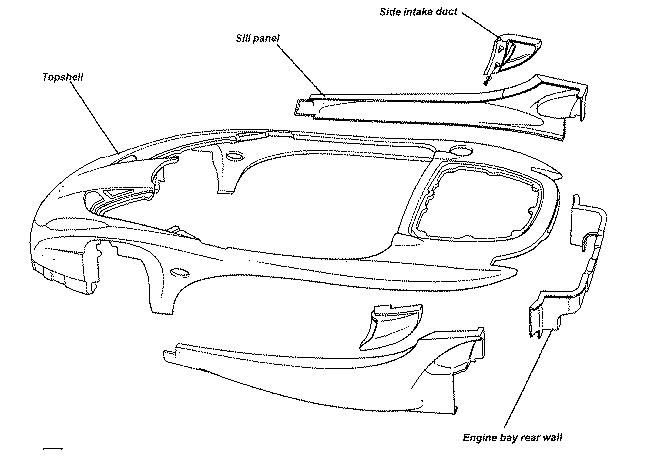
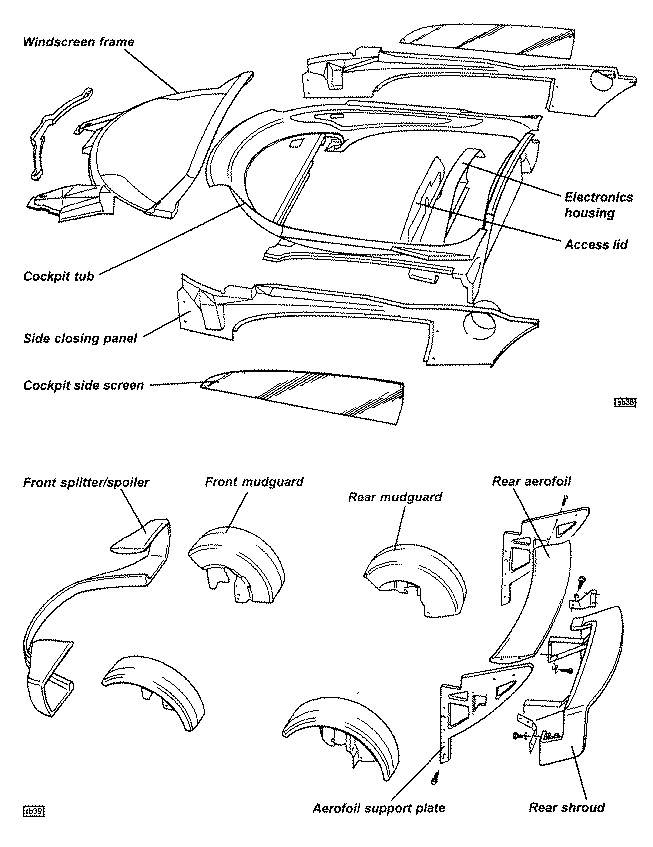
SUSPENSION
& BRAKES
The
340R is fitted with the Elise Sport suspension package which includes
adjustable spring platform Koni dampers with the shorter and stiffer
springs, and the uprated front anti-roll bar in Nylon chassis mounting
blocks. Standard Elise
wishbones are used, with standard 'integral stud' ball jointed toe-links
on the rear. All cars use the
forged steel rear hub carriers.
Two
variations of suspension geometry are specified; one for road use (with
Yokohama or Pirelli tyres); and one optimised for track use with increased
negative camber and toe settings. Ride
height for both applications is common at 100mm front and 110mm rear, with
sport kit steering rack positioning plates factory fitted.
ENGINE
The 340R engine is the
VHPD version of the Rover 1.8 K series in (132.5kw/177 bhp/180.4ps) road tune.
Engine management is based on that used for the Lotus type 918 V8
engine, with that engine's electronic controller, ignition coil pack, and
other engine management components. For
engine management diagnosis, the 'Tech 1' tool should be used with the V8
cartridge T000T1307F, referring to fault codes as listed in Service Notes
Manual Section EMM (L082T0327J). The
codes applicable to the 340R are listed in the service notes supplement.
Other new features of this
engine include a revised, higher efficiency, inlet manifold/throttle body,
shorter than that used previously on the 190, and an increased volume
intake air box, fed with air via a trunking terminating at the left hand
bottom corner of the engine bay.
Resonator Valve: Incorporated in the intake trunking is a resonator
butterfly valve which is controlled by the engine management system, and
is designed to suppress intake noise under certain engine operating
conditions. The valve is
spring loaded to the normally open position, but is closed by vacuum when
accelerating with wide throttle through the lower gears at about 30 -
40mph.
Air Cleaner.. The Elise 340R uses two identical conical foam air
cleaner elements contained within the air intake trunking; a primary
filter mounted at the inlet end of the trunking; and a secondary filter
mounted immediately after the resonator valve. When the vehicle is
operated in a relatively clean environment, the primary filter should be
cleaned every 'A service, and the secondary filter every 'B'service, but
where a dusty or smog laden atmosphere prevails, more frequent servicing
will be required dependent on the level of pollution.
When removing either
filter, take care not to contaminate the engine side of the duct or airbox
with dirt. Follow the filter
manufacturer's cleaning instructions..
1
.
Dislodge any large embedded dirt by tapping the filter gently.
Brush with a soft bristle brush to remove other dirt.
2.
Spray Pipercross foam air filter cleaner liberally onto the entire
filter. Let soak for 10
minutes.
3.
Never use other cleaning agents e.g. gasoline, caustic strong
detergents or solvents. Never use steam cleaners or a high-pressure car wash.
Doing so will invalidate the warranty.
4.
Rinse off the filter with low-pressure tap water from the clean
side to the dirty side. This will remove dirt and not drive it into the filter.
5.
Always let excess water drain from the filter Let the filter dry
naturally. Never use
compressed air; open flame or hot air dryers.
6.
After cleaning the filter, Pipercross Dirt Retention Additive (DRA)
must be re-applied. Pipercross DRA is a very efficient high tack polymer.
Never use motor oil, diesel fuel, ATF or WD40.
7.
Re-install the filters and intake ducting.
Exhaust
System: The 34OR engine uses a special exhaust manifold fabricated
from 45mm diameter steel tube leading via a flexible section to the
standard catalytic converter and then into a new transverse muffler.
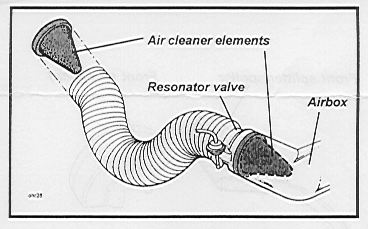
TRANSMISSION
A
close ratio transmission with 4.2.-1 final drive is used, in common with
the Elise 111 S.
INTERIOR
The
interior continues the minimalist theme of the standard Elise, but shares
few components with the standard car:
- The fascia top is scalloped to a lower level, meeting the chassis scuttle beam, from which an alloy cockpit divider extends downwards to the floor. A curved instrument mounting rail, of composite construction extends across the fascia, and houses the speedo and tacho. The cockpit divider is used to mount a vertical row of push button switches.
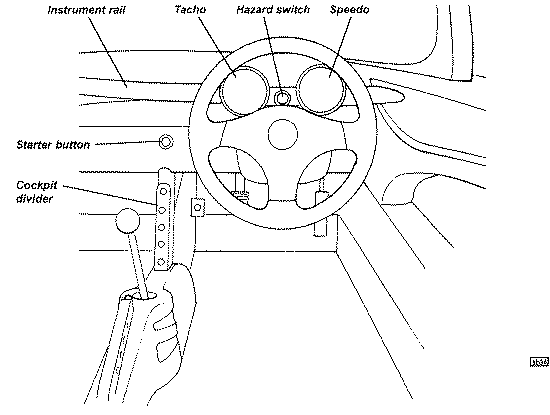
- Special lightweight
composite seats are trimmed in Alcantara suede and leather, with carbon
effect leather reinforcement patches.
- 4-point seat belt
harnesses are provided for both driver and passenger, with a race approved
5th point adaptor kit available if required.
The buckle is attached to the outboard lap strap, with other straps
plugging into appropriate slots in the buckle.
A single press of the red button on the buckle releases all straps.
The FIA approved competition adaptor kit includes a crutch strap
and a twist release buckle. - The two instruments include the various tell
tale lamps, with the speedo also including an LCD panel to display fuel
quantity by bar graph, a digital coolant temperature display, and a total
distance and trip recorder. - The vertical row of switches in the cockpit
divide houses push switches for the following functions, listing
downwards: panel illumination/trip reset; side marker lamps; headlamps;
rear fog; heated windscreen. The
hazard warning switch in sited between the two instrument, and a starter
button is positioned in the centre of the fascia.
-
The heated windscreen operates (when requested) only when the engine is
running, and for a maximum time period of 15 minutes. - Two auxiliary power
sockets are provided at the rear of the cockpit centre divide, to
accommodate heated (motorcycle type) suits, or similar equipment. The sockets are powered only when the engine is running at
over 2,000 rpm, with a maximum allowable current draw of 15 amps from each.
-
A rudimentary heater is provided in the form of a hot air duct linking a
portion of the engine radiator outlet airflow to a driver's footwell vent.
SECURITY
As
the 340R uses a Lotus engine management controller, the security system
(Lucas 5AS) used on the standard Elise is not fitted.
In its place, a Meta security system is used as either an electronic
immobiliser meeting Thatcham category 2 requirements, or, as an optional
upgrade, a full alarm system incorporating cockpit intrusion sensing and a
self powered siren, which meets Thatcham 1.
Full
details of the security system are contained in the Elise Service Notes 340R
Supplement, but in summary: Passive
Immobilisation will be activated 20 seconds after switching off the
ignition, and is indicated by the alarm LED sited centrally on top of the
fascia blinking once every 2 seconds. To
mobilise the engine, press once the button on the transmitter key.
Mobilisation will be acknowledged by the tell tale going out.
To
Arm the Alarm: Press the transmitter button for about 2 seconds.
This command will be acknowledged by: - Two flashes of the hazard
warning lamps;
-
The tell tale on the fascia top lighting, and blinking off once a second.
After a set-up period of 25 seconds has elapsed, the tell tale blink
pattern will invert; becoming mainly off and blinking on once a second.
Check
that these indications occur. If
not, press the button a second time, as the first press may have only
switched off the passive immobilisation (see above).
To
Disarm the Alarm: To disarm the alarm prior to entering the vehicle, or
if the alarm has been triggered, press once the button on the transmitter
key. This command will be
acknowledged by: - One flash of the hazard warning lamps;
-
Extinguishing of the alarm tell tale on the fascia top.
If
the vehicle battery is to be disconnected on a car with an upgraded
alarm;
-
Before disconnecting the battery, ensure that the alarm system is disarmed.
-
On reconnection of the battery, the alarm will automatically be set.
Have the transmitter ready to disarm.
ELECTRICAL
Fuses
& Relays
The
main fusebox is located in the passenger footwell. and is protected by a
clear plastic cover. Twenty two
slots are provided for 'Littel' type fuses, which are numbered and coloured
according to their amperage rating. A
relay block adjacent to the fusebox houses eight relays, with a further two
relays located nearby.
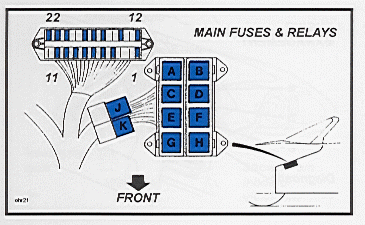
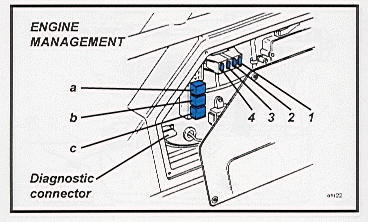

Engine
management fuses, relays and diagnostic connector plug, are mounted on the
cabin rear bulkhead protected by an access panel retained by threaded
fasteners. Fuses
Slot Rating
Circuit
1
20A Fuel
pump, injectors
2
3A
Engine management, OBD2
3
7.5A
Engine management, canister purge, idle
4
7.5A
Ignition coil
Relays
·a Engine management
ignition supply
· b Starter solenoid
· c Fuel pump, injectors
The
main alarm system fuse is located in an individual
If
any fuse is found blow repeatedly, no repair should be attempted until a
Lotus dealer or competent auto electrician has been consulted.
Upgrading a fuse rating, or interchanging any of the relays or
modules, could result in permanent damage to a circuit or electrical
component.
Fuse colours:
2A - Black;
5A - Orange;
15A - Light Blue;
3A - Violet;
7.5A - Brown;
20A - Yellow;
4A - Pink;
1 OA - Red;
25A - Clear.
MAINTENANCE
& LUBRICATION
Lubricants
are as for standard Elise. The
maintenance schedule is basically the same except the distance interval is
reduced from 9,000 miles (1 5,000 km), to 6,000 miles (l 0,000 km) to reflect the harder usage
profile of the vehicle.
For normal road use, the engine oil and filter should be changed in
accordance with this schedule, but for cars frequently used on track days,
oil and filter should be changed every 3,000 miles (5,000 km).
For cars used in speed competitions, oil and filter should be
changed every 2 meetings.
Maintenance
schedules for the 340R are available in packs of 25 under part number
LSL382.
TECHNICAL DATA
Tyres
Standard
Type
Yokohama A038-R
Size - front
195/50 R 1 5 82V
- rear 225/45 R16 89W
- pressure (cold) -
front 1.6
bar (23 lb/in 2)
- rear
1.7 bar (25 lb/in 2)
Optional
Type
Pirelli P Zero (refer Service Notes section GF)
Size - front
185155 R15 81V
- rear
225145 ZR16 89Y
- pressure (cold) -
front 1.6
bar (23 lb/in 2)
- rear
1.9 bar (27.5 lb/in 2)
Wheels
Type
Magnesium alloy, 4 nut fixing
Size - front
6J x 15 ET10
- rear
8J x 16 ET10
Wheel nut torque
80 - 85 Nm (59 - 63 lbf.ft)
Dimensions
Overall length
3620
mm
Overall width
1702 mm
Overall height (at kerb weight) 1080 mm
Wheelbase 2300 mm
Track - front 1432
mm
- rear
1459 mm
Ground clearance (at kerb weight)
110 mm
Approach angle 12.40 deg
Departure angle 280 deg
Unladen
weight - total
701 kg
>inc. full
- front 278
kg
>fuel tank
- rear
423 kg
>
Unladen
Dry Weight - total 658 kg
Maximum
weight - total
928 kg
incl.
- front 387
kg
occupants
- rear
541 kg
& luggage
Trailer
towing Not permissible
Capacities
Engine oil (refill inc. filter)
4.5 litre (7.9 imp. pt)
High/low dipstick mark difference
1.0 litre (1.8 imp. pt)
Transmission oil
2.1 litre (3.7 imp. pt)
Fuel tank
36.4 litre (8.0 imp.gall)
Cooling system
8.0 litre (1.8 imp.gall)
Front Suspension
Type
Independent. Upper and lower wishbone; co-axial
coil spring/telescopic damper unit; anti-roll bar
Ride height (for geometry check)
- front 1
00 mm below front end of chassis sider
- rear 1 1 0 mm
below rear end of chassis sider
Steering axis
Inclination 12' nominal
Castor
+ 3.80; ± 0.20
max. side/side 0.2'
Road
use (Yokohama A036-R or Pirelli
P Zero tyres):
Camber
- 0.50; + 0. 1 0, - 0.20
max. side/side 0.2'
Alignment
0.2 mm toe-out overall; + 0.2 mm, - 0
Dry
track use (Yokohama A038-R tyres)..
Camber
- 1.80; + 0.1', - 0.20
max. side/side 0.20
Alignment
0.5 mm toe-out overall; + 0.2 mm, - 0
Rear Suspension
Type
independent. upper and lower wishbone
coil
spring/telescopic damper. Toe control link.
Ride height (for geometry check)
- front 1 00 mm
below front end of chassis siderail
- rear 1 1 0 mm
below rear end of chassis siderail
Road
use (Yokohama A038-R or Pirelli
P Zero tyres):
Camber
- 2.00; + 0.20, - 0
max.side/side 0.2'
Alignment 1.5 mm
toe-in each side; + 0.2 mm,-0
max.side/side 0.2 mm
Dry
track use (Yokohama A038-R tyres):
Camber
- 2.7'; ± 0.20
max.side/side 0.2'
Alignment
2.5 mm toe-in each side; + 0.2 mm,-0
max.side/side 0.2 mm